by Sandra Dean: The use of Aloe vera on the skin is a tradition that’s among the oldest natural health and beauty treatments in recorded history…

Hailed as the ‘plant of immortality’ by the ancient Egyptians, it was used by the celebrated queens Nefertiti and Cleopatra to maintain their famous beauty.
And the ancient Greeks and Romans employed it for uses as diverse as treating hair loss and healing the wounds of soldiers after battle.
The popularity of its use has continued through to modern times.
It’s regularly used in skin care for its ability to soothe and moisturize the skin. And it’s a popular salve for a range of skin disorders.
In this article, we’ll take a deeper look at the benefits of Aloe vera for skin.
And then I’ll show you a few of the ways that you can easily get started using it at home.
What Is Aloe Vera?
First of all, let’s take a look at what it is.
Aloe vera is a small perennial shrub with thick, triangular, and fleshy green leaves.
Also commonly known as Aloe barbadensis miller, it’s believed to have originated in Sudan before being spread to the Mediterranean region in antiquity, and subsequently around the rest of the world in tropical climates.
Prized for its healthy healing properties, the manufacture of the extract from the plant is amongst the largest botanical industries on the planet.
Composition
Aloe vera contains a huge number of potentially bioactive compounds.
In fact, the number of identified compounds that can interact with your body and skin currently stands at more than 75 and includes the following (1):
-
Vitamins
-
Enzymes
-
Minerals
-
Sugars
-
Phenolic Compounds
-
Fatty Acids
-
Hormones
-
Amino Acids
-
Salicylic Acid
-
Lignins
-
Saponins
These are found in the juice of the plant, and the clear gel that’s contained in the inner layer of the leaves.
It’s the gel that’s most commonly used by people for skin care. But, drinking the juice is also claimed to have health benefits.
Is Aloe Vera Good For Your Skin?
The history of scientific research into the beneficial properties of Aloe vera for the skin has produced some positive results in support of its moisturizing, protective, and healing properties.
However, the evidence obtained is not always strong enough to be considered conclusive.
Undoubtedly, there is a need for larger controlled trials to take place to fully evaluate its effectiveness in the areas in which it has shown promise.
A lot of the evidence to support its use is anecdotal, and Aloe vera remains very popular with natural health and beauty enthusiasts for its perceived benefits for skin.
It’s frequently included in skin care preparations and can be found in a range of personal care and beauty products including soaps, facial moisturizers, sun lotions, shampoos, makeup, shaving creams, and body lotions.
Benefits & Uses

Moisturizing
Aloe vera is well known for its ability to moisturize the skin.
It contains mucopolysaccharides which are thought to aid skin hydration by acting as humectants that attract and bind moisture, preventing its loss.
In one study that looked at the effect on skin hydration of different concentrations of Aloe vera extract in a cosmetic formulation, it was shown that the extract had a positive effect on the water content of the stratum corneum (2).
The final conclusion was:
Our results show that freeze-dried Aloe vera extract is a natural effective ingredient for improving skin hydration, possibly through a humectant mechanism. Consequently, it may be used in moisturizing cosmetic formulations and also as a complement in the treatment of dry skin.
One of the great things about it is that it doesn’t leave a greasy finish to your skin.
And in contrast to some of the popular facial oils, it won’t block your skin pores which can lead to breakouts. This makes it good for use by people with dry skin, and those with oily skin.
Anti-aging
Not only will moisturization improve the appearance of your skin, but Aloe vera could also have exciting anti-aging benefits that could help it to look more youthful as you age.
Aloe vera is rich in antioxidants, including the vitamins C and E, beta-carotene, and phenolic compounds that can neutralize the free radicals that are created in the skin after exposure to UV light.
Damage caused by these free radicals can affect the structural proteins of the skin giving rise to lines and wrinkles.
In addition, it’s been observed that topical application of Aloe vera results in the generation of an antioxidant protein called metallothionein in the skin.
This protein helps to protect against UV radiation by scavenging free radicals and prevents the suppression of superoxide dismutase and glutathione peroxidase, two important enzymes in the skin that protect against oxidative damage.
And it doesn’t stop there.
It also has a stimulatory effect on fibroblasts in the skin, which are responsible for producing collagen and elastin (3). This could help to increase the elasticity of the skin, reducing the appearance of wrinkles.
In a study that looked at the effect of dietary Aloe vera gel on aging skin, supplementation for 90 days resulted in a significant improvement in facial wrinkles and increased elasticity (4).
Acne
As a natural treatment for acne and pimples, Aloe vera appears to have a lot going for it.
Some of its constituents have proven antibacterial properties and can kill harmful bacteria on the skin, and it contains compounds that have an anti-inflammatory effect that could be useful in treating an inflammatory condition like acne.
There’s also a huge number of anecdotal reports from people who have successfully used it as part of their acne treatment.
But unfortunately, we still await clinical trials that can demonstrate exactly how effective it is.
However, there is some recent evidence that supports its use.
In a 2014 study, the combination of Aloe vera gel with topical retinoids was found to be better at treating acne than the retinoids on their own (5).
60 patients with mild to moderate acne were split into two groups of 30. Group 1 was treated with 0.05% tretinoin cream. Group 2 received a 0.05% tretinoin cream that contained 50% Aloe vera gel.
The two groups used the cream for 8 weeks after which their condition was assessed.
The tretinoin and Aloe vera gel group showed a significantly better improvement in both non-inflammatory and inflammatory lesions compared to the other group.
Skin Conditions
Because it contains a number of bioactive compounds with anti-inflammatory properties, you would think that Aloe vera would also show promise as a treatment for other inflammatory skin conditions.
And it’s starting to look like that might be the case.
Anecdotal evidence has long suggested its use for the treatment of skin problems such as eczema, dermatitis, and psoriasis.
And although larger clinical studies are needed to gain conclusive data, there are some scientific studies that support its use.
In one study, 60 patients with psoriasis were recruited for a placebo controlled comparison (6).
They were split into two groups of 30, with one group applying Aloe vera extract in a hydrophilic cream, and the other applying the placebo cream without the extract.
The study ran for 16 weeks, with monthly follow-ups for a further 12 months. The end results of the study were that 83.5% of patients using the Aloe vera extract cream were cured. Only 6.6% of patients using the placebo cured their psoriasis.

In a different study into the effects of Aloe vera extract on seborrheic dermatitis, 44 patients were split into two equal groups and treated with either an emulsion formulated from the extract or a placebo (7).
Comparison of the two groups after treatment showed a significant improvement in symptoms in the group treated with Aloe vera extract compared to the control group.
The global improvement rate as assessed by dermatologists was 58% for the Aloe extract group and 15% for the placebo group. As assessed by the patients themselves it was 62% and 25%.
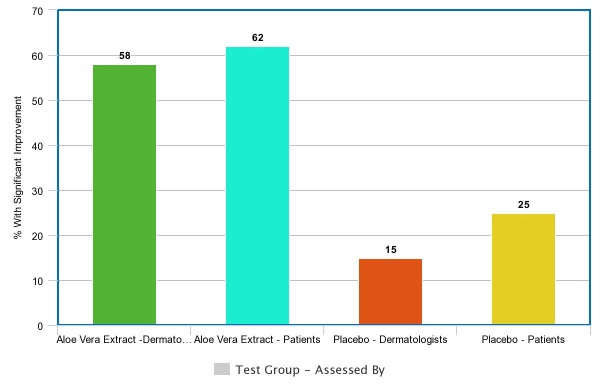
The conclusion of the study was as follows:
The results of the present study indicate that Aloe vera (A. barbadensis) crude extract emulsion is effective in the therapy of patients with seborrheic dermatitis.
Sunburn
One of the most common uses of Aloe vera is to soothe sunburn.
With its ability to hydrate the skin and relieve inflammation it can reduce the itchiness and stinging that can develop after excessive sun exposure.
In one study that looked at the ability of Aloe vera gel to reduce UV induced redness of the skin, a significant improvement was seen compared to a control group that used a placebo gel (8).
This supports its use in aftersun lotions and as a simple home remedy.
Anti-fungal
Aloe vera extract contains a number of known antiseptic agents that can inhibit the growth of fungi.
These include salicylic acid, lupeol, cinnamonic acid, urea nitrogen, sulfur, and polyphenols.
This could make it useful for treating harmful fungi that infect the skin. For example, salicylic acid is known to inhibit Candida albicans (9).
Wounds & Burns
One of the traditional uses of Aloe vera that has attracted a lot of scientific attention is its ability to aid the healing process.
A number of studies on both animals and people have returned encouraging results when looking at wounds and burns.
Aloe contains a polysaccharide called glucomannan and a growth hormone called gibberellin that interact with fibroblasts in the skin, stimulating their proliferation and increasing the production of collagen and the degree of collagen cross-linking (1).
And an increased synthesis of dermatan sulfate and hyaluronic acid can be seen at the wound site after oral consumption and topical application in animal studies (10).
This helps to accelerate wound contraction and the rate at which it heals.
Studies into the healing of burns involving human patients suggest that Aloe vera might be effective at improving the healing of first and second degree burns (11).
And there is a small study that demonstrated the ability of Aloe vera and collagen plastering to completely heal a leg ulcer (12).
Promising results, and the evidence suggests it could help you to add some Aloe vera gel to any cuts, scratches, or minor burns you pick up. But more research will be required to further examine and confirm its wound healing potential.
Razor Burn
Shaving your skin can literally be a pain. It can leave your skin feeling dry, sore, and itchy, and can result in unsightly razor bumps.
Fortunately, the soothing anti-inflammatory properties of Aloe vera make it a great aftershave lotion or a key ingredient in a homemade shaving gel.
It moisturizes the skin and relieves the itching, leaving your skin feeling soft, smooth, and irritation free.
Here’s a simple recipe you can use to make an Aloe vera shaving gel:
Directions For Use:
1. Purchase a jar of organic Aloe vera gel, a bottle of organic argan oil, and a bottle of rose essential oil (or an essential oil that you prefer).
2. Get a small jar with a lid to keep the shaving gel in.
3. Use a tablespoon to measure out 3 parts gel to 1 part argan oil into the small jar.
4. Add 6 drops of essential oil for every tablespoon of ingredients already added.
5. Mix the ingredients together.
6. Use your fingers to spread the shaving gel on the area of your body you are about to shave.
7. Keep the jar with its lid on in a cool, dark place when not using it.
Hyperpigmentation
Exposure to UV light from the sun, inflammation, and hormonal changes are all common occurrences that can lead to an overproduction and accumulation of melanin in the skin and the appearance of dark spots.
Fortunately, there is some evidence to suggest that Aloe vera could have a use for reducing areas of hyperpigmentation, including age spots and melasma.
Studies in animals have shown that the aloin it contains can reduce the appearance of melanin in the skin causing skin lightening (13).
How To Use Aloe Vera For Skin
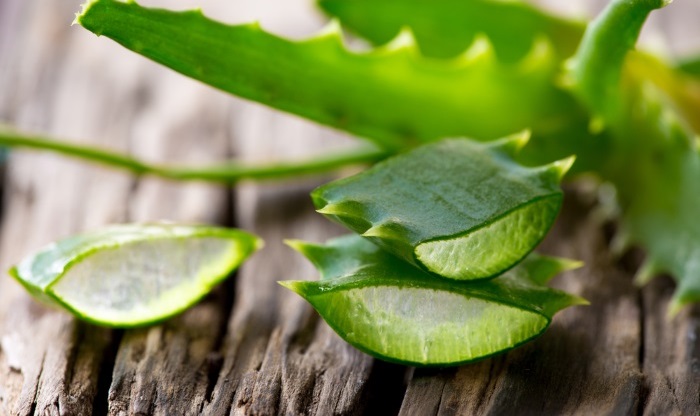
Aloe vera can be used on its own or in combination with a range of natural skin care ingredients to make face masks and lotions.
Here are some recipe ideas that you can consider trying:
Honey & Aloe Vera Face Mask
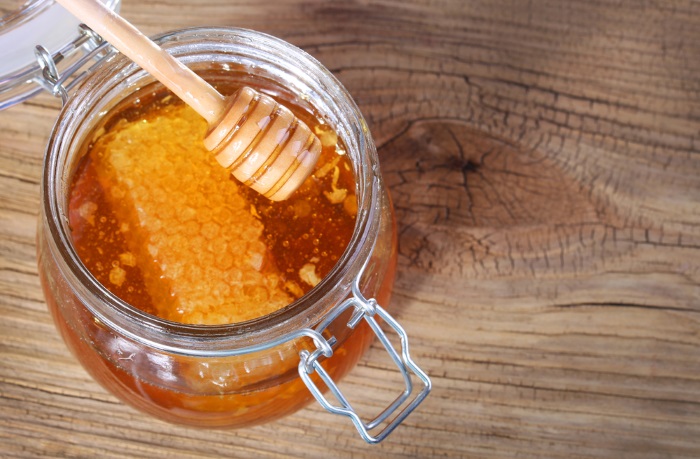
Honey helps to moisturize and gently exfoliate, leaving soft, smooth, and glowing skin.
Directions For Use:
1. Get a jar of raw, organic honey, and a bottle of Aloe vera gel.
2. Get a small bowl.
3. Add 1 tablespoon of the honey and 1 tablespoon of the gel and mix together.
4. Apply the face mask using your fingers.
5. Leave the mixture on your skin for approximately 20 minutes before washing off.
Coconut Oil & Aloe Vera Moisturizer
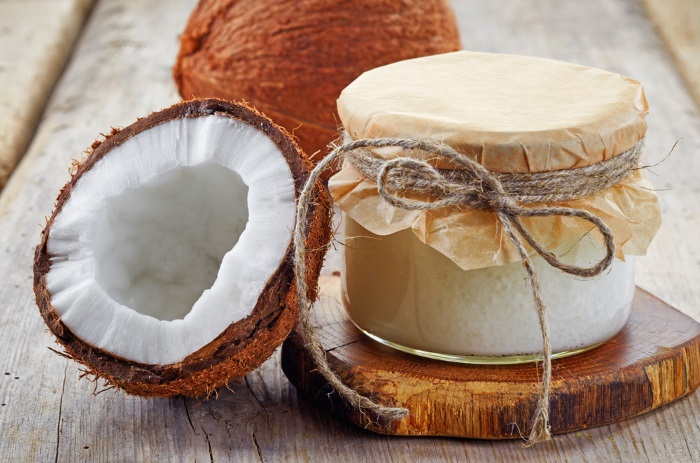
Coconut oil moisturizes the skin and helps to protect it from aging. It can also help to relieve skin conditions like eczema and psoriasis.
Directions For Use:
1. Get a bottle of organic, virgin coconut oil and a bottle of Aloe vera gel.
2. Put ½ a cup of the gel into a bowl.
3. Add ⅓ of a cup of the coconut oil to the bowl and mix together using a hand or electric whisk.
4. If you want to add several drops of your favorite essential oil, do so before you mix the ingredients.
5. Put the moisturizer into a small glass jar with a lid.
6. Use your fingers to apply the moisturizer to your skin.
7. You can use this on your face everyday and overnight.
8. Keep the jar in the fridge for future use.
Basil & Aloe Vera Lotion

Basil essential oil has antioxidant and anti-inflammatory properties. And studies have demonstrated that when combined with Aloe vera the two together have an enhanced acne fighting effect.
Directions For Use:
1. Firstly you need to purchase a bottle of basil essential oil and a bottle of Aloe vera gel.
2. A 1 tablespoon of the gel into a small bowl.
3. Add 6 drops of the essential oil and mix together.
4. Spread the mixture over your skin with your fingers.
5. Use daily for best results.
Side Effects & Precautions
-
The majority of people find that Aloe vera is soothing and moisturizing for the skin.
However, a small minority of people report that it can cause skin irritation, a burning sensation, and generalized dermatitis in people with sensitive skin.
Before using it for the first time you should test if you have an allergic reaction to it. Rub a small amount into the back of your arm and leave for approximately 20 minutes.
If you suffer a reaction then discontinue use.
Related Questions
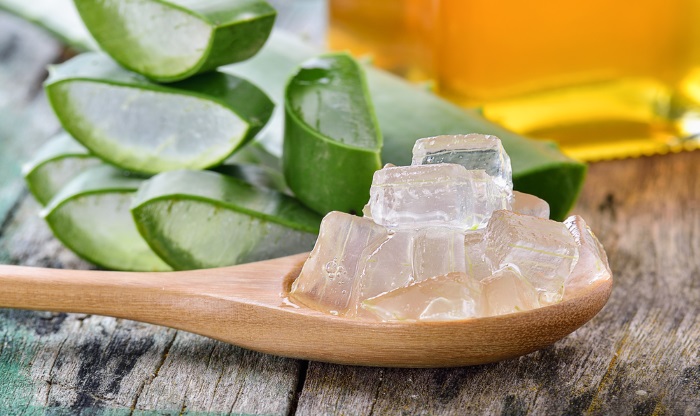
Is Aloe Vera Good For Scars?
This is a claim that’s widely made on natural health websites online. But unfortunately there’s no evidence that Aloe vera will significantly reduce the appearance of existing scars, and no obvious reason why it would do either.
Anecdotal reports suggest that it can help to fade the sort of skin blemishes seen after acne lesions have healed, but it’s unlikely to actually remove acne scars.
Because studies indicate the possibility that it can increase the rate of wound healing there’s a chance that it might lead to better scarring after burns and wounds have healed. But this has not been examined in clinical studies.
Can Aloe Vera Help Stretch Marks?
Anecdotal reports have suggested that Aloe vera could help to reduce the appearance of stretch marks, but there’s no scientific evidence to support these claims.
It’s unlikely to remove existing stretch marks.
Can Aloe Vera Help Rosacea?
Aloe vera has anti-inflammatory properties that could help to calm the inflammatory manifestations of the condition (14). But no scientific studies have actually measured its effectiveness.

















































